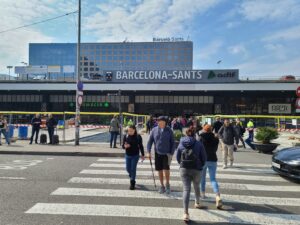If you’re planning a trip to Spain, you may be wondering about the train between Madrid and Barcelona. There a multiple options to travel between the cities, and each has benefits. In a country with excellent rail connection, taking the train is an obvious consideration.

Madrid and Barcelona are the two primary cities of Spain. The former, the capital, is a huge city and has all that goes with being the governmental, financial and cultural center of a nation. The latter is laid back, sunny and a mega tourist destination.

As the two largest and most economically important cities in Spain, there are plenty of reasons for taking the trip from one to the other. Whether it’s for business, tourism or something in between, thousands of people make the trip from Madrid to Barcelona (and vice versa) each day.
The two cities are approximately 300 miles apart. Given the geographical constraints of the area between them, that trip is likely to take about 7 hours via highway.
Lucky for tourists, both cities are extremely easy to get around. Walking is practical. For longer distances, both Madrid and Barcelona have excellent public transportation systems above and below ground. So there’s no need for most visitors to worry about driving. You can get wherever you need via train, bus, metro and taxi.
Thus, the most pragmatic choice for travel between Madrid and Barcelona is the train.
That’s settled. Unfortunately, it’s never that straightforward. Each city has multiple, large train stations. There are multiple places that sell tickets. There are multiple companies operating the journey. All of these factor into when you leave, from which stations you will depart and arrive, the length of the journey and how much it will cost.
We went through all of this just to find a train ticket. Is it more complicated than necessary? Absolutely. Spain has a phenomenally well-connected rail network. You can get almost anywhere by train. But Spanish bureaucracy is infamous for a reason. Anyway, let’s break it down and hopefully simplify the process for you.
Contents
Fast Train or Slow Train?
The train from Madrid to Barcelona used to be a long, slow journey. With the demand for travel between the two cities, hundreds of flights were operated each week. The introduction of the high speed route saw scheduled flights drop substantially and the number of rail passengers traveling between Spain’s two primary cities more than double.
Today, the high speed line is operated by Renfe, Spain’s state-owned train company, Ouigo and Iryo. More than 4 million people travel on the route each year.
Both the fast and slow lines follow the same basic route (not the same tracks), so which one should you take?
The Classic, Slow Train
The old rail line, operated by Renfe, is tedious and frequently stops during its connection of the two cities. It takes over 9 hours and includes 40 stops at smaller stations. It is an excellent choice, albeit often the only choice, if you are a tourists wishing to reach one of the smaller villages between Madrid and Barcelona.
The train runs once a day in each direction, each leaving in the morning. The terminal stations of the slow train between Madrid and Barcelona are Chamartin (Madrid) and França (Barcelona).
For some travelers, the slow train has a certain appeal. I love slow travel. You can see more of the countryside; if time is on your side, I can totally understand that sentiment. Unfortunately, time was not on our side.
The reality is that tourists rarely visit these small communities. I think we’re missing out, but on we go from one metropolis to another.
The High Speed Train
We chose the high-speed train in the interest of time. With less time on this trip to Spain, it made the most sense, affording us nearly an additional day not sitting on trains.
The high speed train takes about 3 hours. It depends on the exact time you leave and number of stops. Trips one or no stops can be closer to 2½ hours, a handful of stops on another train can make the journey closer to 4 hours. Either way, it’s a significantly shorter trip than the slow train.
The primary benefit of the high speed train from Madrid to Barcelona is the departure options. Departures begin early in the morning, around 6 AM, and continue until around 9 PM. Seven days a week.

The terminal stations are Puerta de Atocha (Madrid) and Sants (Barcelona).

For most travelers, especially if you’re short on time, the high speed train is the obvious choice. It is slightly more expensive, which is discussed next; however, the added flexibility of the timetable really makes it the superior option for travelers simply trying to travel between Barcelona and Madrid.
Some people like the slower journey. I do. I like when trains pull into the little stations along the way. Trying to catch a glimpse of each town, I’m usually wishing I was getting off the train to go and explore. So, next time it is!
Costs
Finding the actual price of the high speed train between Madrid and Barcelona might be the most frustrating part of the journey. Seriously, there are so many variances that seem to affect the price. Spain is such a great place, and the Spanish rail network is excellent, but they might be even better at making things unnecessarily complicated.
Anyway, the prices of the high speed train vary. I’m sure there is some kind of formula, but it seems random.
Time of departure/arrival, day of the week, class of seats and when you purchase tickets all affect the price. Multiple companies operate trains on the line, so this is another factor that has an effect on cost.
Generally, one-way tickets can range from less than €20 to more than €100. I know, that’s not very helpful for budgeting. Unfortunately, it depends on several variables, so here are a few tips to help you find cheaper tickets (and save time doing so) for the train from Madrid to Barcelona:
- Be flexible. The more flexibility you have for your departure/arrival, the better chance you have to save some money.
- Book in advance! If you know your plans beforehand, book your ticket early. On occasion, there are cheap tickets available at the last minute. So I’m told. I’ve never had this experience. In fact I’ve paid significantly more than average.
- Scout the train websites! The operator websites aren’t great (Renfe, in particular, is extremely frustrating to use). Trainline is my go-to website for train tickets in Spain. It is easier to use and often cheaper. Not every operator sells on these sites, so you can also check the timetable on Google for comparison.
Ease and Comfort
After you have the itinerary settled and tickets purchased, the high speed train journey between Madrid and Barcelona is simple, straightforward and comfortable. As advertised, it’s fast.
We traveled on different operators each way, and I have taken other high speed trains in Spain on previous trips. My experiences on Iryo have been the best, but none of them have been uncomfortable or unpleasant. The ride is unbelievably smooth for how fast the train is moving. The seats are large and comfortable. The cars are clean.

If you are running late, most of the trains have services selling snacks. It’s slightly more expensive than you would pay in the city for the same thing, but the service is good.
My perception is that trains in Spain are also safe. Security is visibly present even if a little annoying in the moment. I’ve had my bags run through the scanner on most trips, and it does provide a sense of security. I was shocked on a recent trip in Belgium that there was no security whatsoever to enter the train station or board the train. None at all. Anyone could have stepped on board. In our current world, seeing the train station security in Spain is comforting.
I have no real complaints about the journey, aside from wishing I knew then what I know now about train tickets in Spain. I could have saved money, but that’s part of learning how to travel smarter. And that’s on me. The trains themselves are more than adequate.

I suggest arriving at the train station an hour early. Most likely, you will fly through security and feel like you arrived too early. At times, though, lines through security can back up and cause some anxiety if you’re running late. It’s better to be early than miss your train or cause any undue stress.
How to Get to Puerta de Atocha & Sants Train Stations
Both stations at either end of the Madrid to Barcelona train line are serviced by local Metro. This is usually the easiest and fastest way to get there. You can also reach the stations via local bus systems.
Getting around Madrid is extremely easy. Public transportation is extensive and fairly cheap. The metro station at Puerta de Atocha stops directly beneath the train station.
Barcelona also has great public transit. The Sants Metro is about two blocks from the entrance to Sants train station. It’s easy to find, though. As soon as you emerge from the Metro, the train station is the large building with a big parking lot and lots of people out front. It’s obvious.
The high speed train between Madrid and Barcelona is the best way to travel between the two cities. Spain’s excellent rail network shows off once again. The trains are clean, safe, reliable and, of course, very fast.

Hopefully this breakdown helps you navigate the trip a little easier. Let us know if you have any questions, and enjoy the ride!
Leave a Reply
You must be logged in to post a comment.